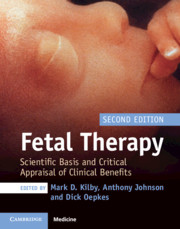Book contents
- Fetal Therapy
- Fetal Therapy
- Copyright page
- Dedication
- Contents
- Contributors
- Foreword
- Section 1: General Principles
- Chapter 1 The Rationale for Fetal Therapy
- Chapter 2 A Fetal Origin of Adult Disease
- Chapter 3 Human Embryology: Molecular Mechanisms of Embryonic Disease
- Chapter 4 Human Genetics and Fetal Disease: Assessment of the Fetal Genome
- Chapter 5 Interventions in Pregnancy to Reduce Risk of Stillbirth
- Chapter 6 Fetal Therapy Choices: Uncertain and Emotional Decisions and the Doctor’s Role in Parental Decision-Making
- Chapter 7 The Ethics of Consent for Fetal Therapy
- Chapter 8 Open Fetal Surgery: Is There Still a Role?
- Chapter 9 The Artificial Womb
- Section 2: Fetal Disease: Pathogenesis and Treatment
- Section III: The Future
- Index
- References
Chapter 3 - Human Embryology: Molecular Mechanisms of Embryonic Disease
from Section 1: - General Principles
Published online by Cambridge University Press: 21 October 2019
- Fetal Therapy
- Fetal Therapy
- Copyright page
- Dedication
- Contents
- Contributors
- Foreword
- Section 1: General Principles
- Chapter 1 The Rationale for Fetal Therapy
- Chapter 2 A Fetal Origin of Adult Disease
- Chapter 3 Human Embryology: Molecular Mechanisms of Embryonic Disease
- Chapter 4 Human Genetics and Fetal Disease: Assessment of the Fetal Genome
- Chapter 5 Interventions in Pregnancy to Reduce Risk of Stillbirth
- Chapter 6 Fetal Therapy Choices: Uncertain and Emotional Decisions and the Doctor’s Role in Parental Decision-Making
- Chapter 7 The Ethics of Consent for Fetal Therapy
- Chapter 8 Open Fetal Surgery: Is There Still a Role?
- Chapter 9 The Artificial Womb
- Section 2: Fetal Disease: Pathogenesis and Treatment
- Section III: The Future
- Index
- References
Summary
The early developing embryo is initially composed of three tissue layers, the ectoderm, endoderm, and mesoderm, that are generated from the epiblast layer of the embryo during week 3 by a process called gastrulation. The ectoderm, the most dorsal layer, gives rise to the skin, whilst the neuroectoderm, which is induced within the ectoderm at the midline, rolls up to form the neural tube and contains the progenitors of the brain and spinal cord (Figure 3.1A). The endoderm, the most ventral layer, gives rise to the epithelial cells of the lungs, prostate gland, the gastrointestinal tract and its associated organs. Sandwiched between these layers is the mesoderm, which is subdivided. The paraxial mesoderm contributes to the musculoskeletal system and dermis in the trunk, the intermediate mesoderm contributes to the urogenital system and internal reproductive organs, the somatic portion of the lateral plate mesoderm forms the skeleton and connective tissue of the limbs together with the body wall, whilst the splanchnic mesoderm portion of the lateral plate mesoderm forms the smooth muscle layers of the endodermal organs. The cardiogenic mesoderm (not shown) contributes to the heart whilst the notochord (or axial mesoderm) gives rise to the nucleus pulposus of the intervertebral disks (Figure 3.1A). In addition, a fourth tissue layer, the neural crest, arises at the interface of the ectoderm and neuroectoderm (Figure 3.1A). Neural crest cells form by an epithelial-mesenchymal transformation and are multipotent and migratory. In the trunk, the neural crest cells contribute to the peripheral nervous system, whereas in the head, neural crest cell derivatives include odontoblasts, together with the skeletal system and dermis of the face. Additionally, cranial neural crest cells contribute to the outflow tract and cushions of the heart. For further details of embryonic development, the reader is referred to Larsen’s Human Embryology [1].
- Type
- Chapter
- Information
- Fetal TherapyScientific Basis and Critical Appraisal of Clinical Benefits, pp. 20 - 35Publisher: Cambridge University PressPrint publication year: 2020
References
- 1
- Cited by

